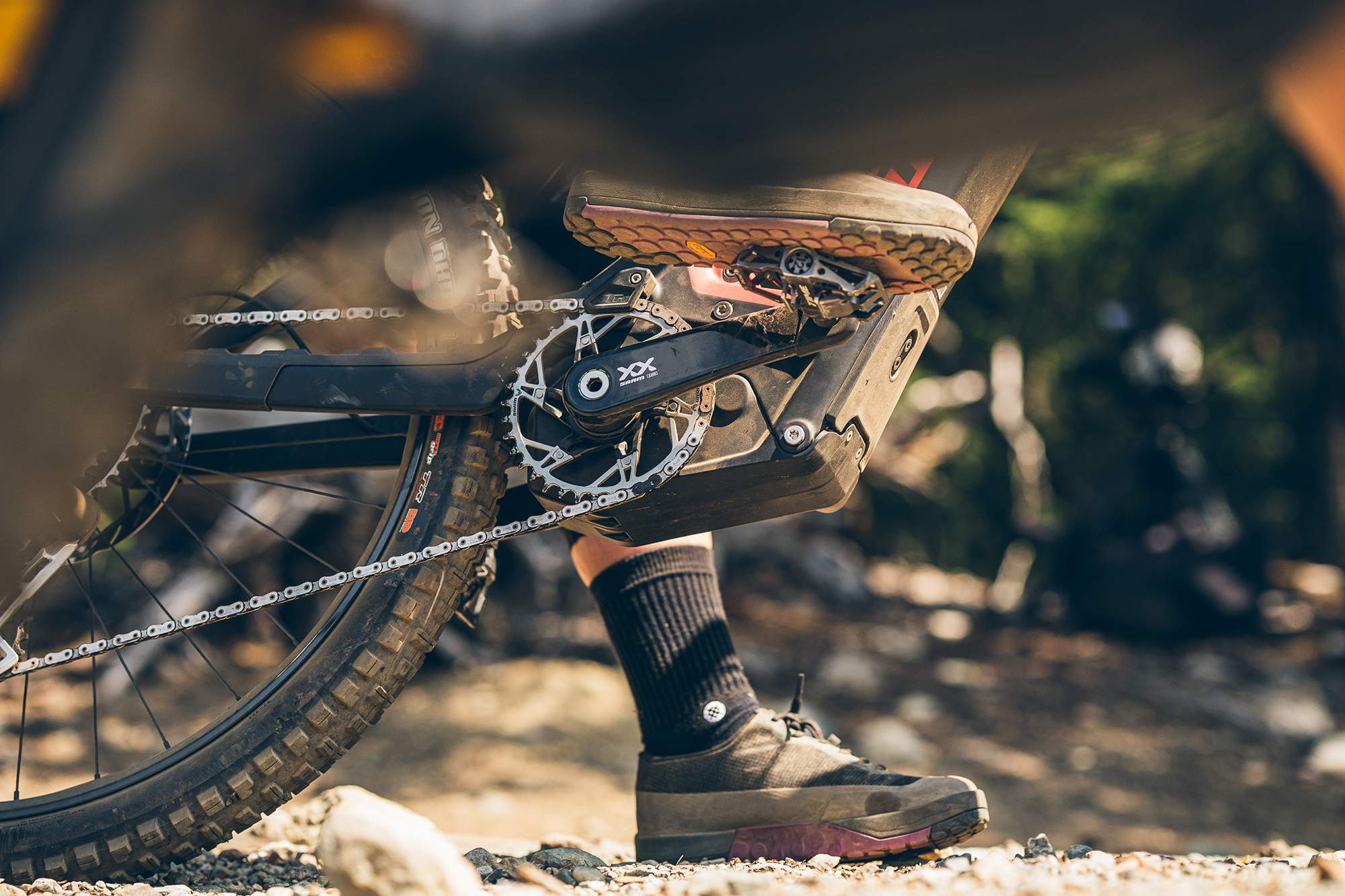The day has finally come when SRAM has officially entered the e-MTB game with the launch of their debut e-MTB motor and power unit called Powertrain.
The motor itself has been developed in collaboration with Brose (think the brand that has been powering Specialized to the head of the e-MTB market for the past bunch of years) but all of the other components that make up the Powertrain system, including the software, has been developed inhouse by SRAM.
Our focus is always on the rider first. The goal of the system was to provide the rider with a complete, wireless, integrated E-MTB system tuned specifically for performance mountain biking. We simplified the ride allowing the rider to focus on the trail.”
Michael Hemme, e-MTB Category Manager
 In a snapshot SRAM’s new Powertrain, which carries the ‘Eagle’ moniker, produces 90Nm of torque and 680W of peak power, which is then fuelled by either a 630Wh or 720Wh battery.
In a snapshot SRAM’s new Powertrain, which carries the ‘Eagle’ moniker, produces 90Nm of torque and 680W of peak power, which is then fuelled by either a 630Wh or 720Wh battery.
So, it’s interesting to note that SRAM have decided to go down the ‘full fat/full power’ route, rather than the ‘SL’ route, with their first dive into the e-MTB world. Another thing we’ve found really interesting about SRAM’s approach to developing Powertrain since we started to learn about it a few weeks ago via a pre-release press kit and a few phone calls back and forth, is that SRAM don’t seem to have gone down the design path of replicating what most other brands are doing in the e-MTB space. For instance, the SRAM motor only features 2 power modes, there’s no handlebar mounted display, no dedicated mode selecting shifter, in fact the entire Powertrain system appears to be stripped bare of clutter and unnecessary gizmos right out of the gate…
Up to this point the e-MTB motor market has been dominated by brands such as Bosch, Shimano, Yamaha, and (ironically) Brose, so with SRAM also now joining the race it will certainly be interesting to follow their progress. With that said, given the fact that SRAM already produce the most advanced electronic drivetrains in the world of mountain biking by way of their deep AXS range, it would be pretty silly not to think that SRAM are entering this race with a significant ‘foot up’ to begin with.
The Powertrain’s motor unit is very, very similar to the existing top of the line Brose motor and one of the things that that means is the unit relies on an internal belt drive system. We’ve always been big fans of Brose belt driven power units because they deliver a silk smooth pedal stroke and minimal friction/noticeable resistance once the motor goes over 25kmp or even when the motor is powered off.
In addition to the motors 2 pre-set power modes/power maps which are named Rally and Range, SRAM have also cleverly designed 2 additional modes: ‘Auto Shift’ and ‘Coast Shift’. Auto Shift, as the name suggests, automatically shifts the rear mech up and down the cassette so that the bike is always in the perfect gear for the section of trail ahead – albeit without the rider needing to have impute. The Coast Shift setting allows the chainring to move freely from the cranks, letting you shift while coasting/not pedalling. The concept of both of these settings certainly raises plenty of questions in our minds and we’re eager to take a Powertrain bike out for a rider in the search for answers – so stay tuned!

Our Auto Shift algorithm is like a bike’s sixth sense, deciding when to shift so riders can stay laser-focused on their ride. It’s not just smart tech, it’s the ultimate riding companion.”
Dominique Fuss, Electrical and Software Engineer working on the Powertrain project.
Back to the theory, as we touched on earlier SRAM were mindful that they didn’t want to add any additional clutter to the handlebars with their Powertrain system, so there’s no additional remotes or bar mounted displays. Instead, to change engine modes their system utilises the versatility of AXS pod controllers – the exact same pod unit that controls gear shifts when using an AXS Transmission / drivetrain or Reverb AXS dropper post. Whilst it is expected that riders will choose to use the top button on their left side pod for engine mode changes, the exact configuration of which buttons control which function are completely customisable via SRAM’s easy to use AXS app.
For the initial market launch SRAM have partnered with only 3 bike brands; Transition, Nukeproof and Propain. But don’t expect to spot a Powertrain powered bike out on the trails any time soon, from what we’ve heard all 3 manufactures won’t be landing bikes here in Oz for at least a couple of months.
How does Powertrain actually ride? Well as you might have guessed we haven’t actually ridden it yet. That said, we are hoping to get our hands on a Powertrain powered test bike as soon as possible and we’re currently working with SRAM to make that happen. So stay tuned to the mag and our digital channels for further updates to follow…
For all of the latest SRAM product news and tech info head to www.sram.com











